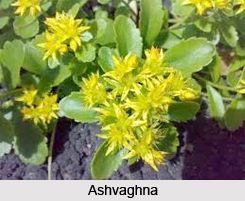 Ashvaghna was widely used in India centuries ago as a garden ornamental plant.
Ashvaghna has since naturalized in the plains throughout the nation.
Ashvaghna was widely used in India centuries ago as a garden ornamental plant.
Ashvaghna has since naturalized in the plains throughout the nation.
Properties of Ashvaghna
The roots of this medicinal plant constitute the Ayurvedic drug Karavirah. The latter is a well-known poison but if carefully administered, it can be used as a powerful cardiac tonic. Ashvaghna is bitter, diaphoretic hot, astringent, carminative, anthelmintic and useful as an external application for treating ailments like ulcers, leprosy and skin diseases.
Common Names of Ashvaghna
The common names for Ashvaghna differ from region to region. While the botanical name is Cascabela thevetia, this medicinal plant is also known as Chinakarab, Haldi Korubi, Kolilphul, Kolkaphul in Bengali; Lucky Nut Tree, Yellow Oleander in English; Pilakanera, Pilakanir, Pilokanera in Gujarati; Kaner, Kulkephul, Pila Kaner, Zard Kunel in Hindi; Kadukasi, Kanogalu in Kannada; Manja-Areli, Pachcha-areli, Pachchai-Alari in Malayalam; Pivalakanher, Sherani in Marathi; Konyar Phul in Oriya; Ash-Vaha, Ashvaghna, Ashvamaraka, Ashvantaka, Divyapushpa, Haripriya, Karavirah, Pachchai-Alari, Shatakunda in Sanskrit; Manjalaleri, Pachaiyalari, Tiruvachippu in Tamil and Pachcha-Ganeru in Telugu.
Structure of Ashvaghna
Ashvaghna is a large evergreen poisonous shrub that grows to a height of 6 metres. The leaves of Ashvaghna are alternate, glabrous, simple, narrowed at both ends, 10-15 cms long and acute.
Flowers of Ashvaghna
The Ashvaghna flowers are bright yellow or pinkish-yellow, mildly scented and borne in few-flowered, terminal cymes. The fruits of this medicinal plant are triangular and laterally compressed, fleshy and contain 2-4 seeds. Flowers and fruits start blossoming on Ashvaghna tree from March to July; sometimes they are seen throughout the year.
Roots of Ashvaghna
The roots of Ashvaghna are made into a plaster and applied to relieve tumours. The seeds of this tree are used as an alexiteric and as a purgative in the treatment of rheumatism and dropsy. A mixture of the crushed raw fruits of Ashvaghna is used by the tribal inhabitants of Udaipur District in Rajasthan as a wash for boils. A blend of the seeds acts as a violent emetic, hinders respiration, and may cause paralysis of the heart. However, this mixture is sometimes used to treat hemorrhoids.
Seeds of Ashvaghna
The seed kernels act as a contact poison; when mashed with soap they are used as an effective insecticide. A tincture of the Ashvaghna bark is used as a bitter cathartic, emetic and antipyretic in irregular fevers; in larger doses it can be poisonous. The leaves of Ashvaghna are emetic and purgative. The latex from the plant is put on cuts and wounds among the inhabitants of Bhadrak District in Odisha. The milky juice obtained from all parts of the plant is poisonous.
Concentration of Ashvaghna
Ashvaghna is widely concentrated in Indian states like Himachal Pradesh, Punjab, Haryana and Chandigarh.











